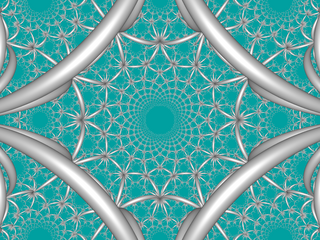| Order-4 square tiling honeycomb | |
|---|---|

| |
| Type | Hyperbolic regular honeycomb Paracompact uniform honeycomb |
| Schläfli symbols | {4,4,4} h{4,4,4} ↔ {4,41,1} {4[4]} |
| Coxeter diagrams | |
| Cells | {4,4} |
| Faces | square {4} |
| Edge figure | square {4} |
| Vertex figure | square tiling, {4,4} |
| Dual | Self-dual |
| Coxeter groups | , [4,4,4] , [41,1,1] , [4[4]] |
| Properties | Regular, quasiregular |
In the geometry of hyperbolic 3-space, the order-4 square tiling honeycomb is one of 11 paracompact regular honeycombs. It is paracompact because it has infinite cells and vertex figures, with all vertices as ideal points at infinity. Given by Schläfli symbol {4,4,4}, it has four square tilings around each edge, and infinite square tilings around each vertex in a square tiling vertex figure.[1]
A geometric honeycomb is a space-filling of polyhedral or higher-dimensional cells, so that there are no gaps. It is an example of the more general mathematical tiling or tessellation in any number of dimensions.
Honeycombs are usually constructed in ordinary Euclidean ("flat") space, like the convex uniform honeycombs. They may also be constructed in non-Euclidean spaces, such as hyperbolic uniform honeycombs. Any finite uniform polytope can be projected to its circumsphere to form a uniform honeycomb in spherical space.
- ^ Coxeter The Beauty of Geometry, 1999, Chapter 10, Table III


